air filter RENAULT SCENIC 2009 J84 / 2.G Engine And Peripherals EDC16 Workshop Manual
[x] Cancel search | Manufacturer: RENAULT, Model Year: 2009, Model line: SCENIC, Model: RENAULT SCENIC 2009 J84 / 2.GPages: 273
Page 7 of 273

DIESEL INJECTION
Fault finding – Cleanliness guidelines13B
13B - 7V3 MR-372-J84-13B250$033.mif
EDC16
PROGRAM NO.: C1
Vdiag No.: 51DIESEL INJECTION
Fault finding – Cleanliness guidelines
I - RISKS ASSOCIATED WITH CONTAMINATION
The high pressure direct injection system is highly sensitive to contamination. The risks associated with
contamination are:
–damage to or destruction of the high pressure injection system,
–components jamming,
–a component leaking.
All After-Sales operations must be performed under very clean conditions. This means that no impurities (particles a
few microns in size) should have entered the system during dismantling.
The cleanliness principle must be applied from the filter to the injectors.
What are the sources of contamination?
metal or plastic swarf,
–paint,
–fibres:
–from cardboard,
–from brushes,
–from paper,
–from clothing,
–from cloths,
–foreign bodies such as hair,
–ambient air,
–etc.
II - NOTES TO BE FOLLOWED BEFORE ANY OPERATION
Check that you have plugs for the unions to be opened (set of plugs available from the Parts Department). The plugs
are single-use only. After use, they must be discarded (once used they are soiled and cleaning is not sufficient to
make them reusable). Unused plugs must be discarded.IMPORTANT
Cleaning the engine using a high pressure washer is prohibited because of the risk of damaging connections. In
addition, moisture may collect in the connectors and create electrical connection faults.
IMPORTANT
Before any work is carried out on the high pressure injection system, protect:
–the accessories and timing belts,
–the electrical accessories, (starter, alternator, electric power-assisted steering pump),
–the flywheel surface, to prevent any diesel from running onto the clutch friction plate.
MR-372-J84-13B250$033.mif
Page 9 of 273
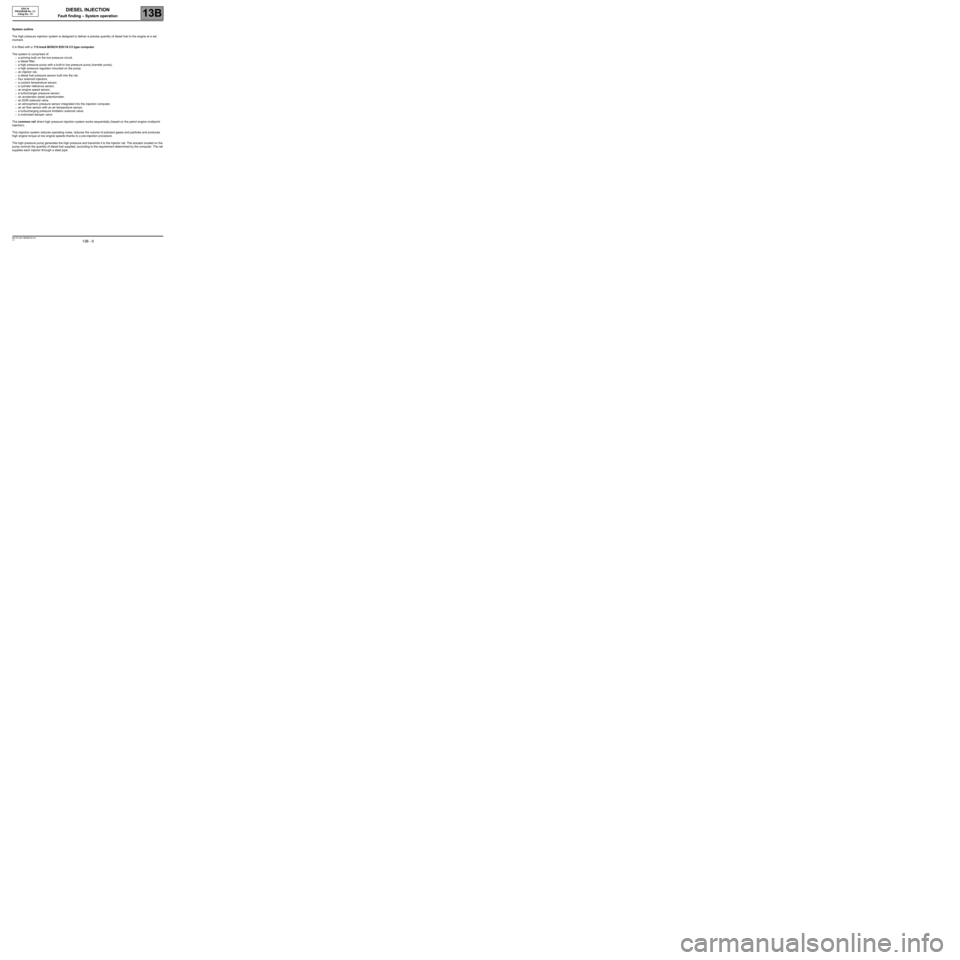
DIESEL INJECTION
Fault finding – System operation13B
13B - 9V3 MR-372-J84-13B250$135.mif
EDC16
PROGRAM No: C1
Vdiag No.: 51DIESEL INJECTION
Fault finding – System operation
System outline
The high pressure injection system is designed to deliver a precise quantity of diesel fuel to the engine at a set
moment.
It is fitted with a 112-track BOSCH EDC16 C3 type computer.
The system is comprised of:
–a priming bulb on the low pressure circuit,
–a diesel filter,
–a high pressure pump with a built-in low pressure pump (transfer pump),
–a high pressure regulator mounted on the pump,
–an injector rail,
–a diesel fuel pressure sensor built into the rail,
–four solenoid injectors,
–a coolant temperature sensor,
–a cylinder reference sensor,
–an engine speed sensor,
–a turbocharger pressure sensor,
–an accelerator pedal potentiometer,
–an EGR solenoid valve,
–an atmospheric pressure sensor integrated into the injection computer,
–an air flow sensor with an air temperature sensor,
–a turbocharging pressure limitation solenoid valve,
–a motorised damper valve.
The common rail direct high pressure injection system works sequentially (based on the petrol engine multipoint
injection).
This injection system reduces operating noise, reduces the volume of pollutant gases and particles and produces
high engine torque at low engine speeds thanks to a pre-injection procedure.
The high pressure pump generates the high pressure and transmits it to the injector rail. The actuator located on the
pump controls the quantity of diesel fuel supplied, according to the requirement determined by the computer. The rail
supplies each injector through a steel pipe.
MR-372-J84-13B250$135.mif
Page 11 of 273
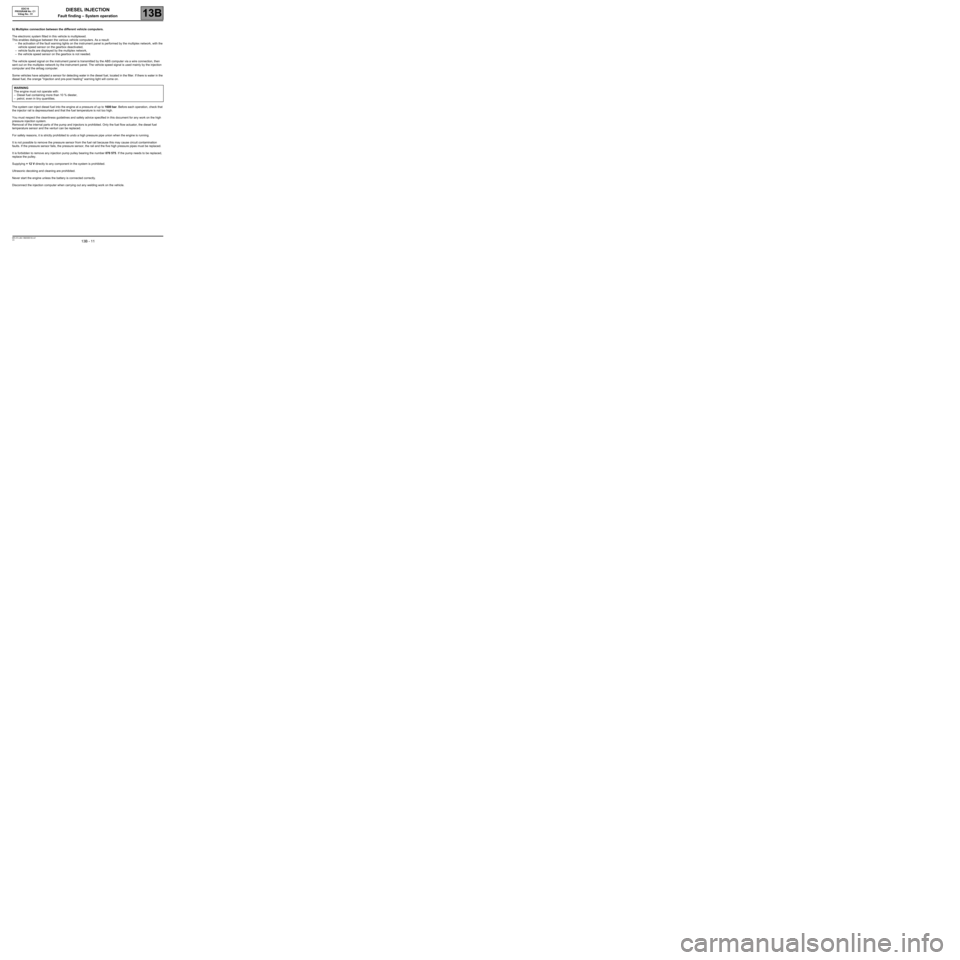
DIESEL INJECTION
Fault finding – System operation13B
13B - 11V3 MR-372-J84-13B250$135.mif
EDC16
PROGRAM No: C1
Vdiag No.: 51
b) Multiplex connection between the different vehicle computers.
The electronic system fitted in this vehicle is multiplexed.
This enables dialogue between the various vehicle computers. As a result:
–the activation of the fault warning lights on the instrument panel is performed by the multiplex network, with the
vehicle speed sensor on the gearbox deactivated,
–vehicle faults are displayed by the multiplex network,
–the vehicle speed sensor on the gearbox is not needed.
The vehicle speed signal on the instrument panel is transmitted by the ABS computer via a wire connection, then
sent out on the multiplex network by the instrument panel. The vehicle speed signal is used mainly by the injection
computer and the airbag computer.
Some vehicles have adopted a sensor for detecting water in the diesel fuel, located in the filter. If there is water in the
diesel fuel, the orange "Injection and pre-post heating" warning light will come on.
The system can inject diesel fuel into the engine at a pressure of up to 1600 bar. Before each operation, check that
the injector rail is depressurised and that the fuel temperature is not too high.
You must respect the cleanliness guidelines and safety advice specified in this document for any work on the high
pressure injection system.
Removal of the internal parts of the pump and injectors is prohibited. Only the fuel flow actuator, the diesel fuel
temperature sensor and the venturi can be replaced.
For safety reasons, it is strictly prohibited to undo a high pressure pipe union when the engine is running.
It is not possible to remove the pressure sensor from the fuel rail because this may cause circuit contamination
faults. If the pressure sensor fails, the pressure sensor, the rail and the five high pressure pipes must be replaced.
It is forbidden to remove any injection pump pulley bearing the number 070 575. If the pump needs to be replaced,
replace the pulley.
Supplying + 12 V directly to any component in the system is prohibited.
Ultrasonic decoking and cleaning are prohibited.
Never start the engine unless the battery is connected correctly.
Disconnect the injection computer when carrying out any welding work on the vehicle.WARNING
The engine must not operate with:
–Diesel fuel containing more than 10 % diester,
–petrol, even in tiny quantities.
Page 83 of 273
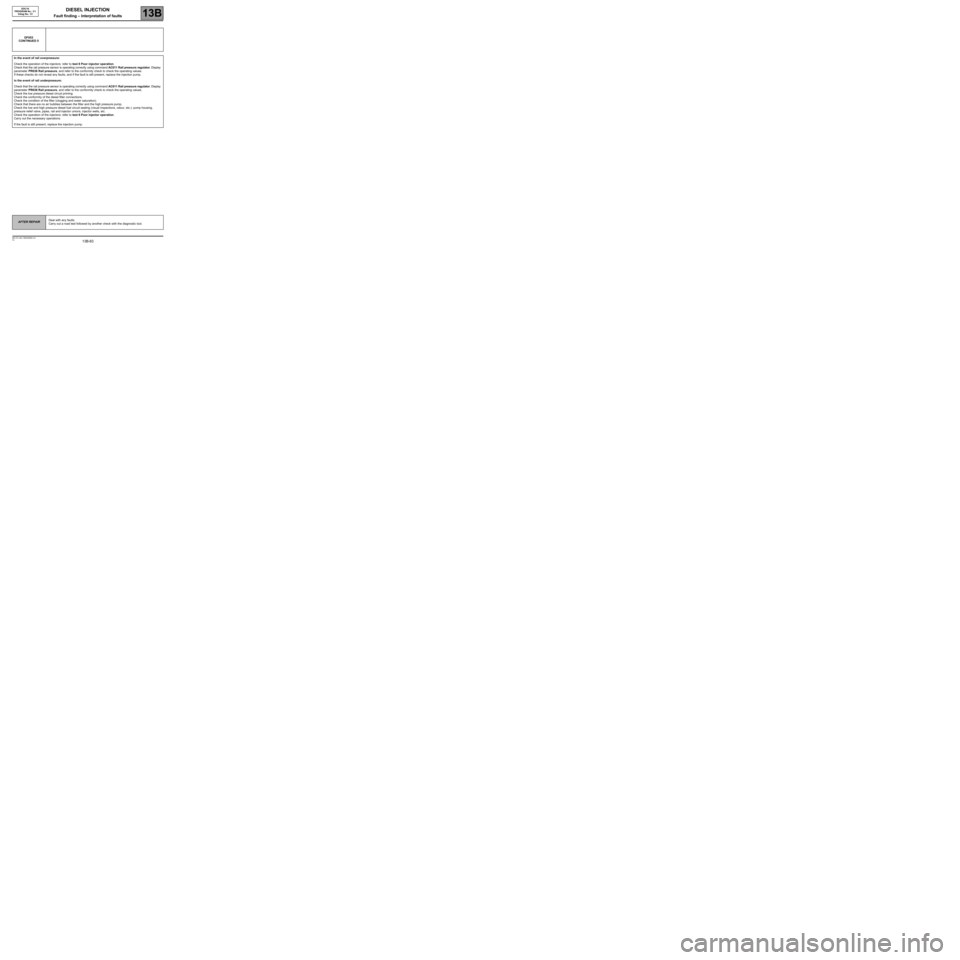
DIESEL INJECTION
Fault finding – Interpretation of faults13B
13B-83V3 MR-372-J84-13B250$360.mif
EDC16
PROGRAM No.: C1
Vdiag No.: 51
DF053
CONTINUED 5
In the event of rail overpressure:
Check the operation of the injectors: refer to test 8 Poor injector operation.
Check that the rail pressure sensor is operating correctly using command AC011 Rail pressure regulator. Display
parameter PR038 Rail pressure, and refer to the conformity check to check the operating values.
If these checks do not reveal any faults, and if the fault is still present, replace the injection pump.
in the event of rail underpressure:
Check that the rail pressure sensor is operating correctly using command AC011 Rail pressure regulator. Display
parameter PR038 Rail pressure, and refer to the conformity check to check the operating values.
Check the low pressure diesel circuit priming.
Check the conformity of the diesel filter connections.
Check the condition of the filter (clogging and water saturation).
Check that there are no air bubbles between the filter and the high pressure pump.
Check the low and high pressure diesel fuel circuit sealing (visual inspections, odour, etc.): pump housing,
pressure relief valve, pipes, rail and injector unions, injector wells, etc.
Check the operation of the injectors: refer to test 8 Poor injector operation.
Carry out the necessary operations.
If the fault is still present, replace the injection pump.
AFTER REPAIRDeal with any faults.
Carry out a road test followed by another check with the diagnostic tool.
Page 94 of 273
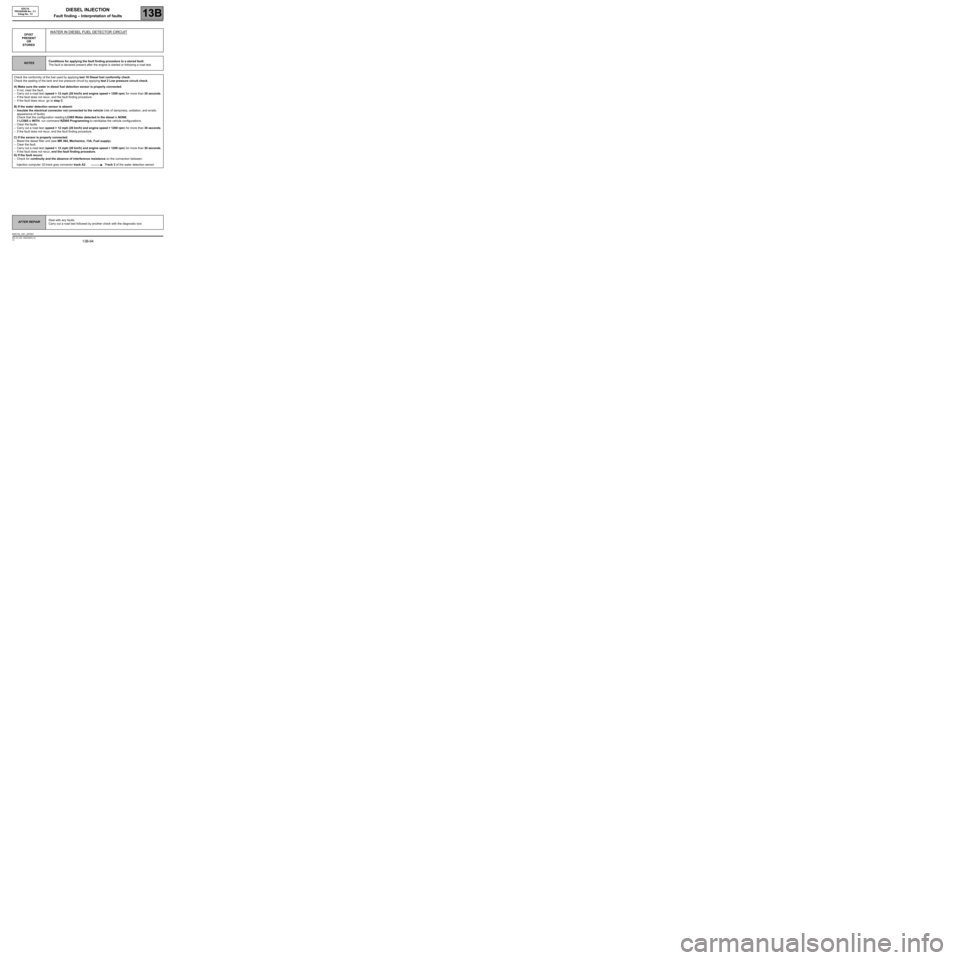
DIESEL INJECTION
Fault finding – Interpretation of faults13B
13B-94V3 MR-372-J84-13B250$405.mif
EDC16
PROGRAM No.: C1
Vdiag No.: 51
DF057
PRESENT
OR
STOREDWATER IN DIESEL FUEL DETECTOR CIRCUIT
NOTESConditions for applying the fault finding procedure to a stored fault:
The fault is declared present after the engine is started or following a road test.
Check the conformity of the fuel used by applying test 10 Diesel fuel conformity check.
Check the sealing of the tank and low pressure circuit by applying test 2 Low pressure circuit check.
A) Make sure the water in diesel fuel detection sensor is properly connected.
–If not, clear the fault,
–Carry out a road test (speed > 12 mph (20 km/h) and engine speed > 1200 rpm) for more than 30 seconds.
–If the fault does not recur, end the fault finding procedure.
–If the fault does recur, go to step C.
B) If the water detection sensor is absent:
–Insulate the electrical connector not connected to the vehicle (risk of dampness, oxidation, and erratic
appearance of faults).
Check that the configuration reading LC065 Water detected in the diesel is NONE.
If LC065 is WITH, run command RZ005 Programming to reinitialise the vehicle configurations.
–Clear the faults.
–Carry out a road test (speed > 12 mph (20 km/h) and engine speed > 1200 rpm) for more than 30 seconds.
–If the fault does not recur, end the fault finding procedure.
C) If the sensor is properly connected:
–Bleed the diesel filter unit (see MR 364, Mechanics, 13A, Fuel supply).
–Clear the fault.
–Carry out a road test (speed > 12 mph (20 km/h) and engine speed > 1200 rpm) for more than 30 seconds.
–If the fault does not recur, end the fault finding procedure.
D) If the fault recurs:
–Check for continuity and the absence of interference resistance on the connection between:
Injection computer 32-track grey connector track A2 Track 3 of the water detection sensor
AFTER REPAIRDeal with any faults.
Carry out a road test followed by another check with the diagnostic tool.
EDC16_V51_DF057
Page 95 of 273
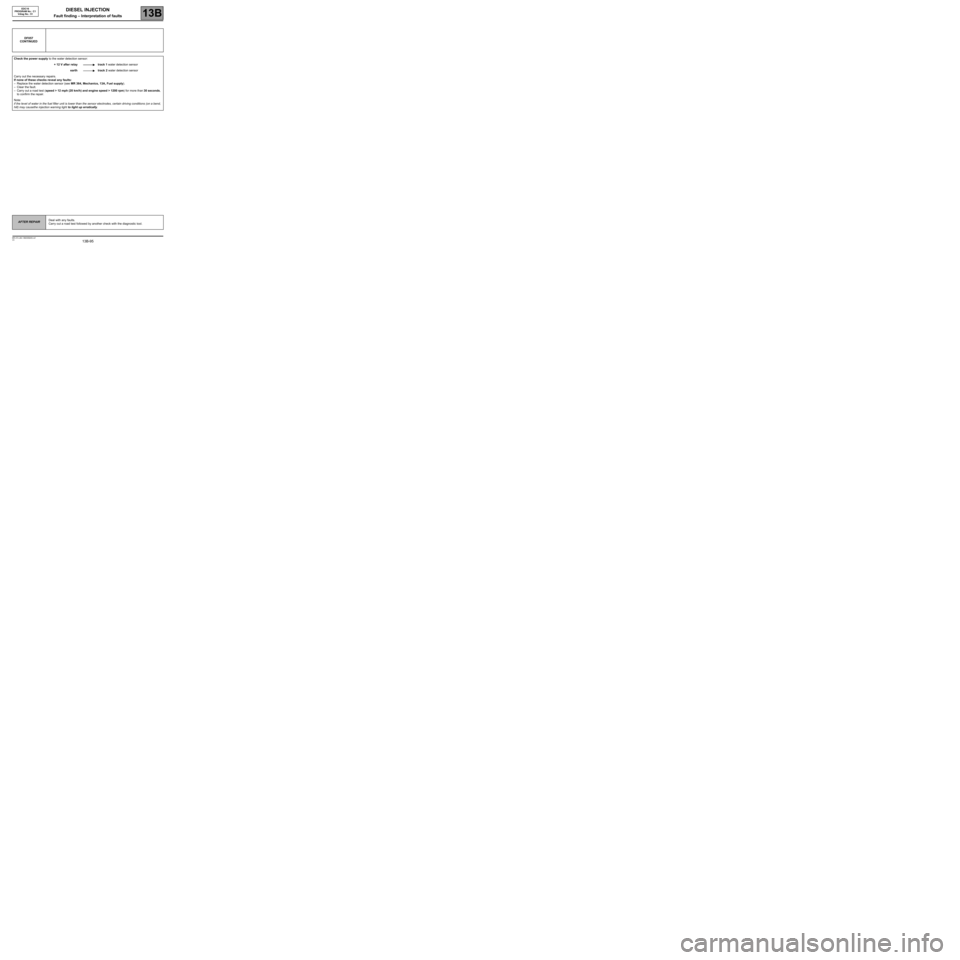
DIESEL INJECTION
Fault finding – Interpretation of faults13B
13B-95V3 MR-372-J84-13B250$405.mif
EDC16
PROGRAM No.: C1
Vdiag No.: 51
DF057
CONTINUED
Check the power supply to the water detection sensor:
+ 12 V after relay track 1 water detection sensor
earth track 2 water detection sensor
Carry out the necessary repairs.
If none of these checks reveal any faults:
–Replace the water detection sensor (see MR 364, Mechanics, 13A, Fuel supply).
–Clear the fault.
–Carry out a road test (speed > 12 mph (20 km/h) and engine speed > 1200 rpm) for more than 30 seconds,
to confirm the repair.
Note:
if the level of water in the fuel filter unit is lower than the sensor electrodes, certain driving conditions (on a bend,
hill) may causethe injection warning light to light up erratically.
AFTER REPAIRDeal with any faults.
Carry out a road test followed by another check with the diagnostic tool.
Page 128 of 273
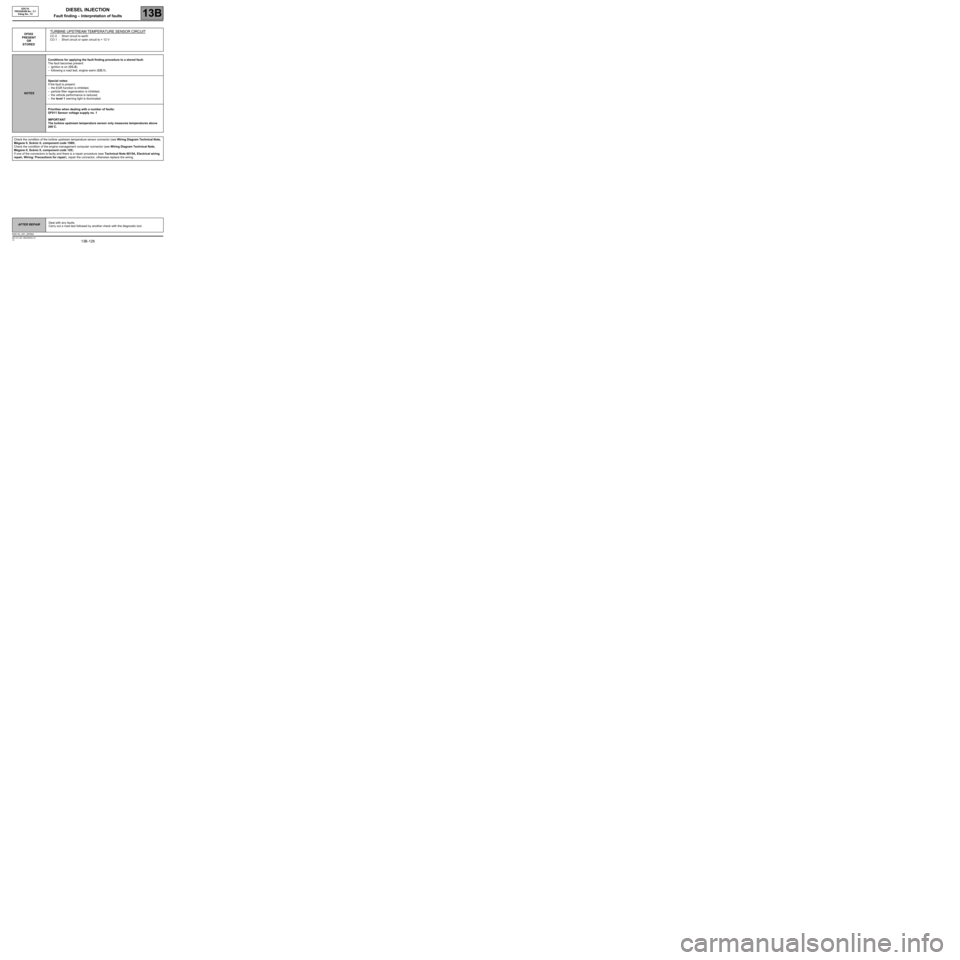
DIESEL INJECTION
Fault finding – Interpretation of faults13B
13B -128V3 MR-372-J84-13B250$450.mif
EDC16
PROGRAM No.: C1
Vdiag No.: 51
DF652
PRESENT
OR
STOREDTURBINE UPSTREAM TEMPERATURE SENSOR CIRCUIT
CC.0 : Short circuit to earth
CO.1 : Short circuit or open circuit to + 12 V
NOTESConditions for applying the fault finding procedure to a stored fault:
The fault becomes present:
–ignition is on (CC.0),
–following a road test, engine warm (CO.1).
Special notes:
If the fault is present:
–the EGR function is inhibited,
–particle filter regeneration is inhibited,
–the vehicle performance is reduced,
–the level 1 warning light is illuminated.
Priorities when dealing with a number of faults:
DF011 Sensor voltage supply no. 1
IMPORTANT
The turbine upstream temperature sensor only measures temperatures above
200˚C.
Check the condition of the turbine upstream temperature sensor connector (see Wiring Diagram Technical Note,
Mégane II, Scénic II, component code 1589).
Check the condition of the engine management computer connector (see Wiring Diagram Technical Note,
Mégane II, Scénic II, component code 120).
If one of the connectors is faulty and there is a repair procedure (see Technical Note 6015A, Electrical wiring
repair, Wiring: Precautions for repair), repair the connector, otherwise replace the wiring.
AFTER REPAIRDeal with any faults.
Carry out a road test followed by another check with the diagnostic tool.
EDC16_V51_DF652
Page 130 of 273
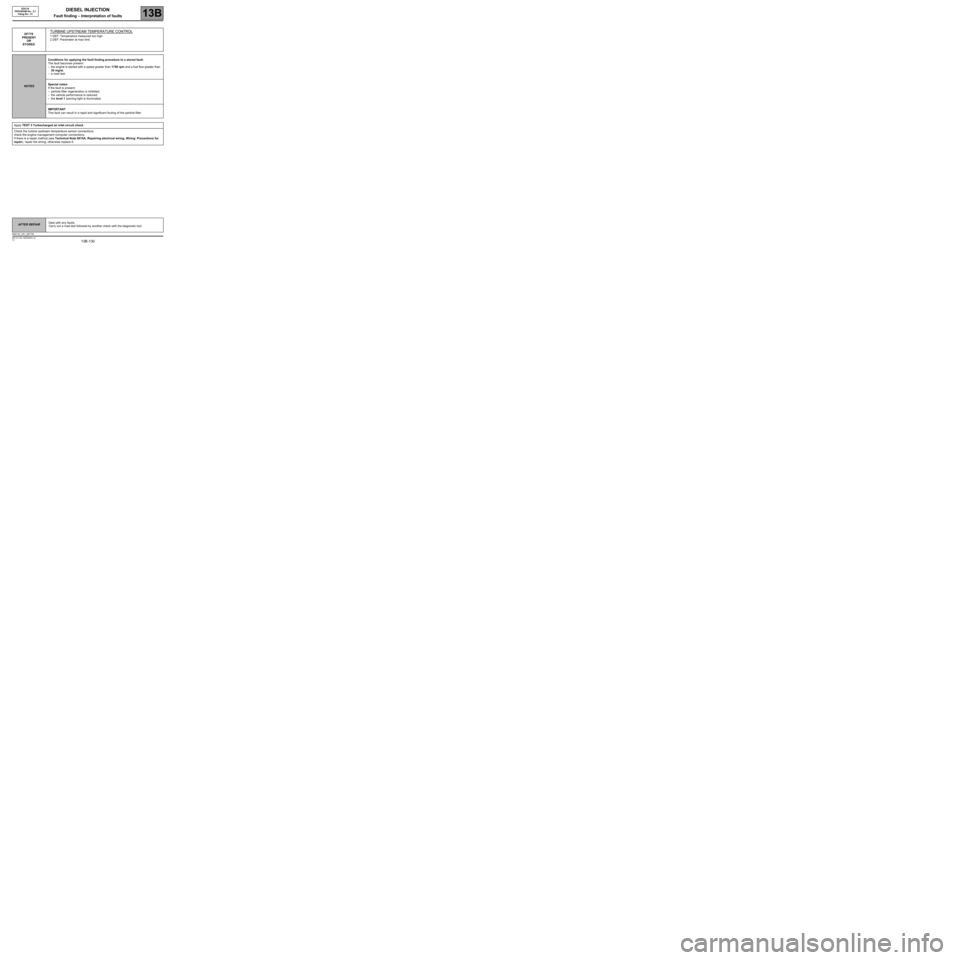
DIESEL INJECTION
Fault finding – Interpretation of faults13B
13B -130V3 MR-372-J84-13B250$450.mif
EDC16
PROGRAM No.: C1
Vdiag No.: 51
DF778
PRESENT
OR
STOREDTURBINE UPSTREAM TEMPERATURE CONTROL
1.DEF: Temperature measured too high
2.DEF: Parameter at max limit
NOTESConditions for applying the fault finding procedure to a stored fault:
The fault becomes present:
–the engine is started with a speed greater than 1750 rpm and a fuel flow greater than
30 mg/st,
–a road test.
Special notes:
If the fault is present:
–particle filter regeneration is inhibited,
–the vehicle performance is reduced,
–the level 1 warning light is illuminated.
IMPORTANT
This fault can result in a rapid and significant fouling of the particle filter.
Apply TEST 3 Turbocharged air inlet circuit check.
Check the turbine upstream temperature sensor connections.
check the engine management computer connections.
If there is a repair method (see Technical Note 6015A, Repairing electrical wiring, Wiring: Precautions for
repair), repair the wiring, otherwise replace it.
AFTER REPAIRDeal with any faults.
Carry out a road test followed by another check with the diagnostic tool.
EDC16_V51_DF778
Page 201 of 273
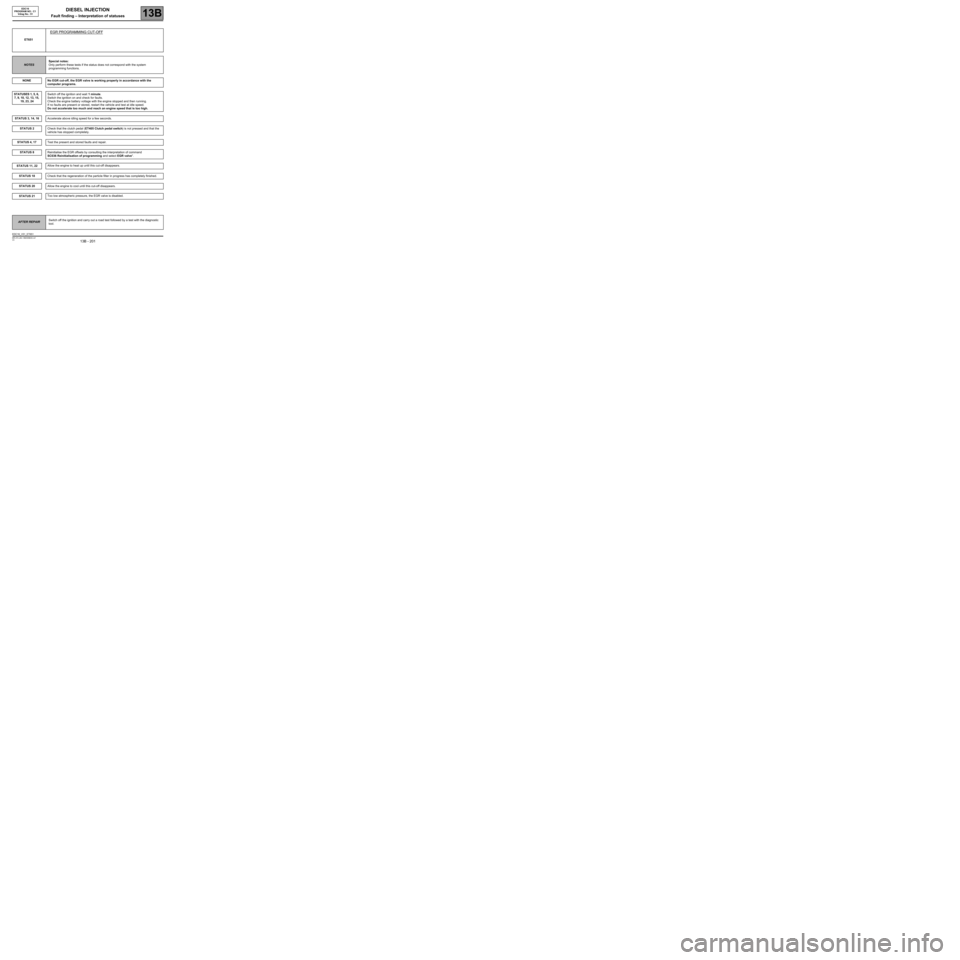
DIESEL INJECTION
Fault finding – Interpretation of statuses13B
13B - 201V3 MR-372-J84-13B250$630.mif
STATUS 18
STATUS 20
STATUS 21
STATUS 11, 22
STATUS 8
STATUS 4, 17
STATUS 2
STATUS 3, 14, 16
STATUSES 1, 5, 6,
7, 9, 10, 12, 13, 15,
19, 23, 24
EDC16
PROGRAM NO.: C1
Vdiag No.: 51
ET651
EGR PROGRAMMING CUT-OFF
NOTESSpecial notes:
Only perform these tests if the status does not correspond with the system
programming functions.
NONE
No EGR cut-off, the EGR valve is working properly in accordance with the
computer programs.
Switch off the ignition and wait 1 minute.
Switch the ignition on and check for faults.
Check the engine battery voltage with the engine stopped and then running.
If no faults are present or stored, restart the vehicle and test at idle speed.
Do not accelerate too much and reach an engine speed that is too high.
Accelerate above idling speed for a few seconds.
Check that the clutch pedal (ET405 Clutch pedal switch) is not pressed and that the
vehicle has stopped completely.
Test the present and stored faults and repair.
Reinitialise the EGR offsets by consulting the interpretation of command
SC036 Reinitialisation of programming and select EGR valve".
Allow the engine to heat up until this cut-off disappears.
Check that the regeneration of the particle filter in progress has completely finished.
Allow the engine to cool until this cut-off disappears.
Too low atmospheric pressure, the EGR valve is disabled.
AFTER REPAIRSwitch off the ignition and carry out a road test followed by a test with the diagnostic
tool.
EDC16_V51_ET651
Page 219 of 273
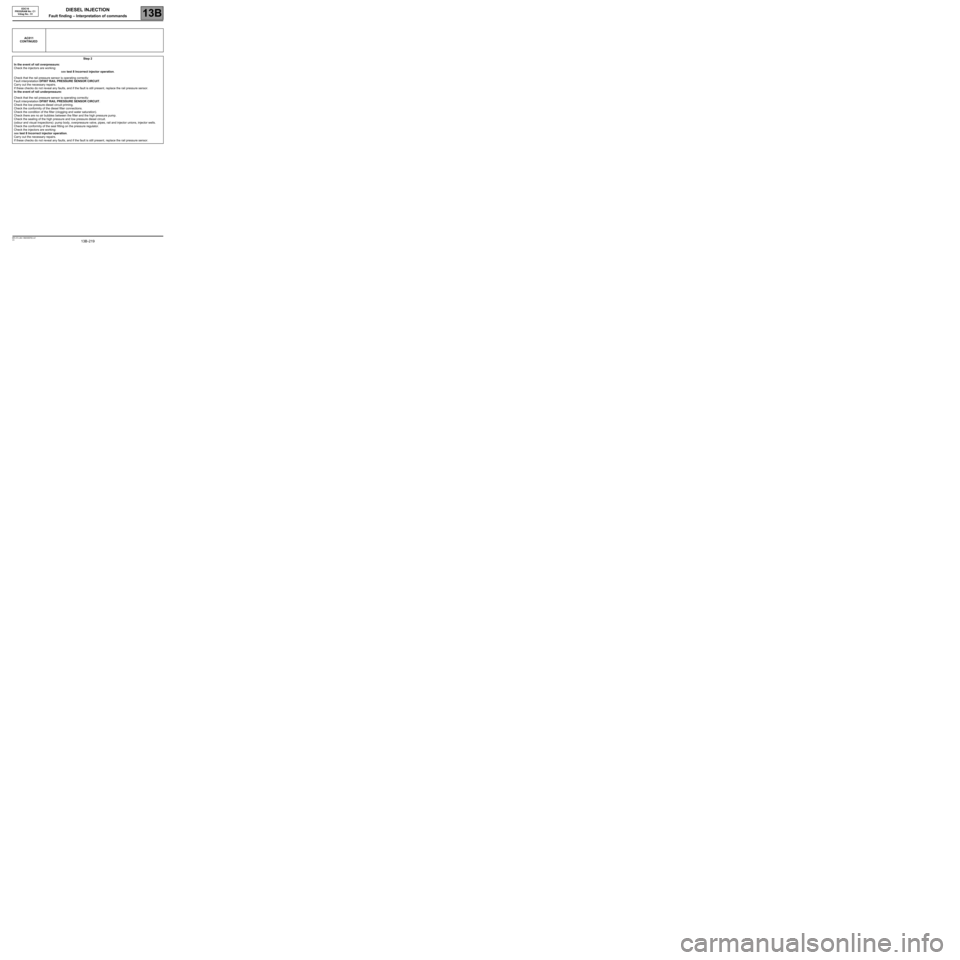
DIESEL INJECTION
Fault finding – Interpretation of commands13B
13B -219V3 MR-372-J84-13B250$765.mif
EDC16
PROGRAM No: C1
Vdiag No.: 51
AC011
CONTINUED
Step 2
In the event of rail overpressure:
Check the injectors are working:
see test 8 Incorrect injector operation.
Check that the rail pressure sensor is operating correctly:
Fault interpretation DF007 RAIL PRESSURE SENSOR CIRCUIT.
Carry out the necessary repairs.
If these checks do not reveal any faults, and if the fault is still present, replace the rail pressure sensor.
In the event of rail underpressure:
Check that the rail pressure sensor is operating correctly:
Fault interpretation DF007 RAIL PRESSURE SENSOR CIRCUIT.
Check the low pressure diesel circuit priming.
Check the conformity of the diesel filter connections.
Check the condition of the filter (clogging and water saturation).
Check there are no air bubbles between the filter and the high pressure pump.
Check the sealing of the high pressure and low pressure diesel circuit.
(odour and visual inspections): pump body, overpressure valve, pipes, rail and injector unions, injector wells.
Check the conformity of the seal fitting on the pressure regulator.
Check the injectors are working:
see test 8 Incorrect injector operation.
Carry out the necessary repairs.
If these checks do not reveal any faults, and if the fault is still present, replace the rail pressure sensor.